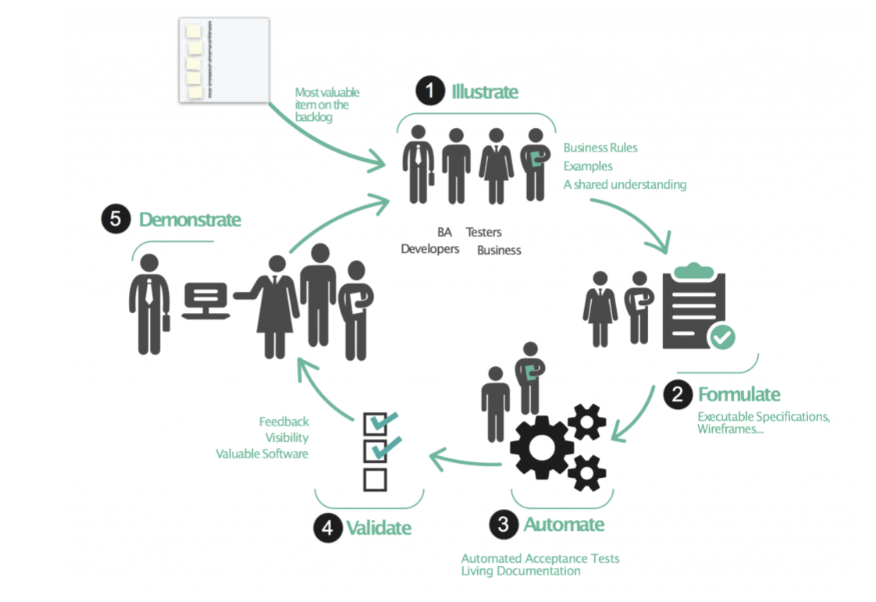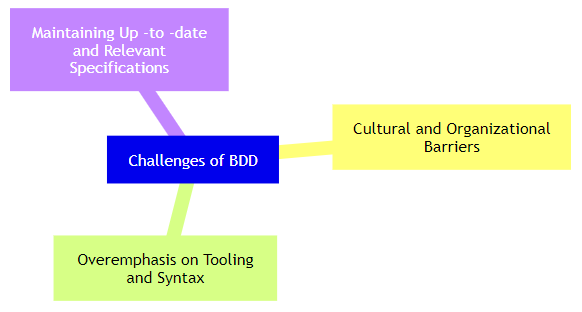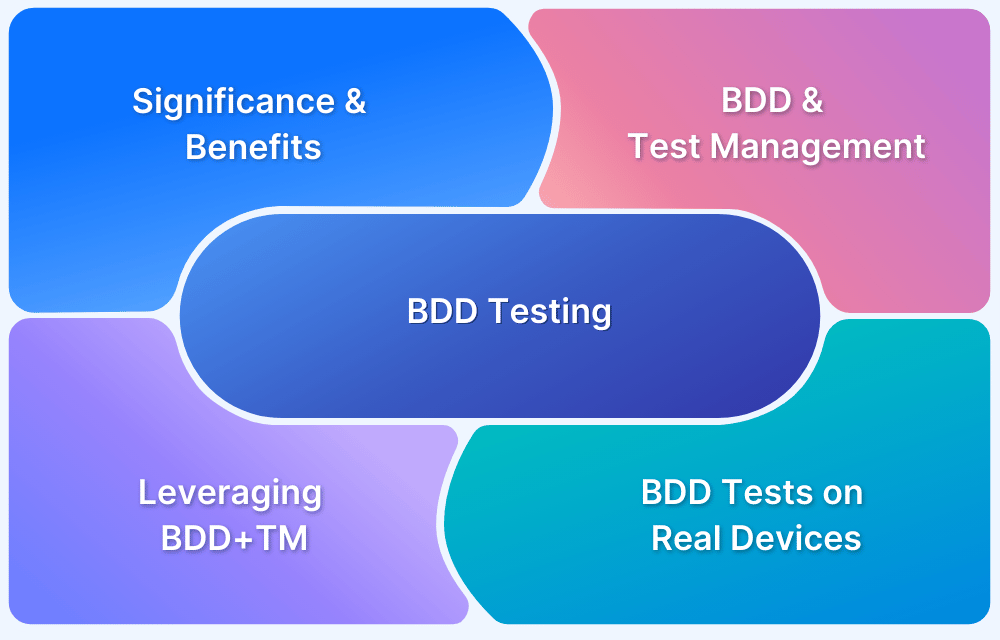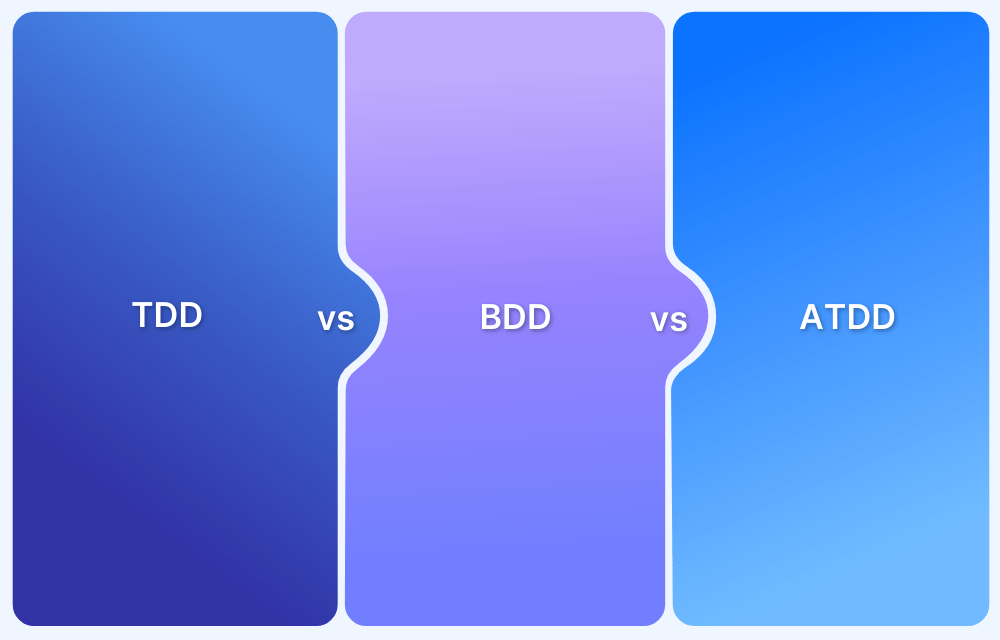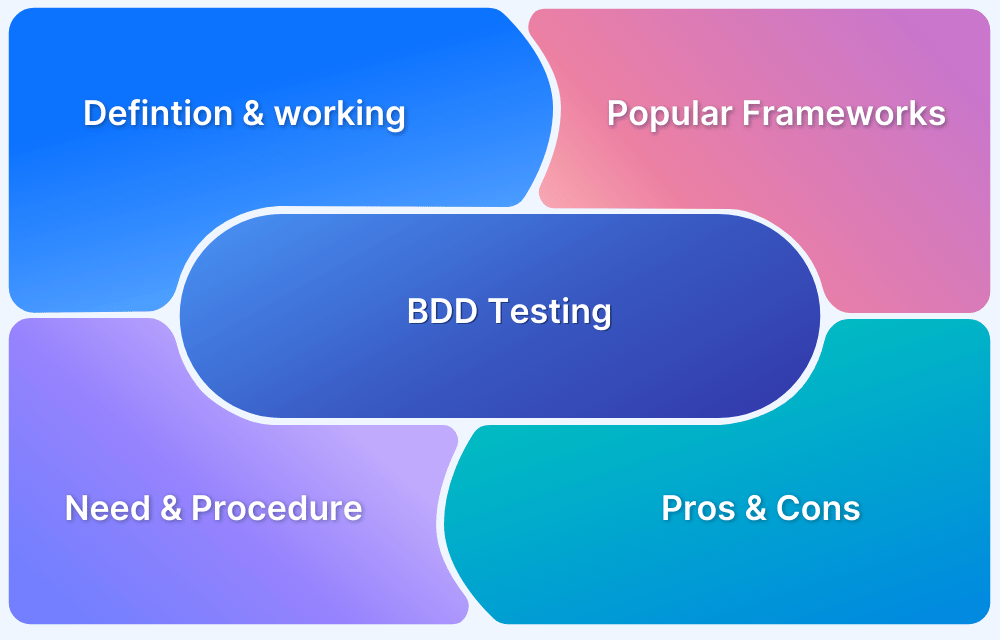What is BDD? (Behavior-Driven Development)
By Hamid Akhtar, Community Contributor - December 17, 2024
As of 2023, Behavior-Driven Development (BDD) continues gaining traction in the software industry. This growth is fueled by the increasing recognition of BDD’s benefits in enhancing collaboration, improving requirement understanding, and facilitating early defect detection.
- As per Market Insights, the adoption of BDD is on an upward trajectory, with an unexpected Compound Annual Growth Rate (CAGR) projected from 2022 to 2029.
- The market size for BDD tools is also expected to reach multi-million USD by 2029, reflecting the growing demand for these tools in the industry.
- As Agile methodologies become more prevalent, BDD is a practical and effective approach for businesses to ensure software quality and meet customer needs.
What is BDD?
BDD (Behavior-Driven Development) is a software development methodology that emphasizes collaboration between developers, testers, and business stakeholders.
BDD focuses on defining the behavior of an application in plain, human-readable language, using scenarios and examples. BDD uses tools like Cucumber or SpecFlow to write tests in “Given-When-Then” format, ensuring clear, shared understanding of requirements.
BDD brings together key stakeholders in the Software Development Process, often called the “Three Amigos” – the Business, Development, and QA teams. Using tests written in plain English allows all stakeholders to understand and agree on the software’s expected behavior, ensuring that the “right product” is being developed.
The three principles of BDD are:
- Focus on the desired behavior or outcomes
- Collaboration between developers, testers, and business stakeholders
- Use of a common language for communication and understanding.
BDD is an evolution of the Test-Driven Development Methodology (TDD), but it shifts the focus from high test coverage to defining the application’s behavior.
- In BDD, behaviors are well-articulated, human-understandable statements that define a specific process in a predetermined format.
- These are stored in “feature files” integrated into the software development process.
- Tools like Cucumber and SpecFlow parse through the behaviors in the feature file and execute the “glue code” that maps behaviors to executable steps, known as “step definitions”.
For example, consider an online shopping platform. A behavior could be “When a user adds an item to the cart and proceeds to checkout, the item should be available for purchase.” This behavior is written in a feature file and then validated during development.
What is the BDD Process?
Think of BDD as a play. In a play, you have characters (the business team, the development team, and the QA team) and a script (the behaviors or requirements).
- The business team is like the playwright, writing the script based on what they want the audience (the users) to experience.
- The development team is like the actors, bringing the script to life on the stage (the software).
- The QA team is like the director, ensuring the actors perform their parts correctly and the play goes as planned.
In BDD, the “script” is written in a language called Gherkin, which uses simple words like “Given”, “When”, and “Then” to describe the behavior of the software. For example, “Given a user is logged in, When they click on the ‘logout’ button, they should be logged out and redirected to the login page.” This script is then turned into automated tests that check if the software behaves as expected.
The beauty of BDD is that everyone involved in the play, from the playwright to the director, understands the script and agrees on the final performance. This way, everyone is on the same page, and the chances of the play being a hit are much higher!
Behavior-Driven Development (BDD) Life Cycle
Behavior-Driven Development (BDD) Life Cycle typically follows a series of steps that ensure clear communication between stakeholders and alignment with business goals. Here are the key stages of BDD Lifecycle:
- Discovery: Gather requirements with stakeholders.
- Define Scenarios: Write behavior scenarios in Given-When-Then format.
- Automate Scenarios: Implement tests using BDD tools.
- Develop: Write code to satisfy the scenarios.
- Test: Run automated tests to verify functionality.
- Refactor: Improve code while maintaining behavior.
- Feedback: Get continuous feedback to improve code.
- Release: Deploy when the system behaves as expected.
- Maintain: Iterate and adapt as requirements evolve.
Advantages of BDD
BDD offers several advantages such as:
- Improved Collaboration: Encourages communication between developers, testers, and business stakeholders, ensuring everyone shares the same understanding of requirements.
- Clearer Requirements: The use of plain language for scenarios helps clarify the functionality and expected behavior of the system.
- Better Test Coverage: Focuses on testing behavior from the user’s perspective, which leads to more relevant and comprehensive test cases.
- Early Detection of Issues: Tests are written before implementation, allowing potential issues to be identified early in the development process.
- Documentation: BDD scenarios double as living documentation that evolves with the system, making it easier for new team members to understand the application’s behavior.
- Increased Quality: By aligning development with business goals and continuously validating behavior, BDD helps improve the overall quality of the software.
Read More: How to achieve Advanced BDD Test Automation?
Limitations of BDD
BDD has some limitations, such as:
- Initial Learning Curve: Teams may face a learning curve when adopting BDD, especially with new tools and the Given-When-Then syntax.
- Time-Consuming Setup: Writing behavior-driven tests in detail can be time-consuming and may delay development, especially in complex projects.
- Overhead in Maintenance: Keeping BDD scenarios up to date with changing requirements can become burdensome, particularly for large or rapidly evolving systems.
- Requires Collaboration: Effective BDD requires continuous and active collaboration between developers, testers, and non-technical stakeholders, which may not always be feasible.
- Not Suitable for All Projects: For projects with minimal user interaction or straightforward functionality, BDD might be overkill, leading to unnecessary complexity.
- Tool Dependency: BDD relies heavily on specific tools (e.g., Cucumber, SpecFlow), which may introduce integration or compatibility issues, especially with legacy systems.
Popular BDD Frameworks
Here’s a list of Popular BDD Testing Frameworks:
1. Cucumber
Cucumber is one of the most widely used BDD frameworks. It allows users to write test scenarios in Gherkin language, which is a simple, human-readable syntax. Gherkin is a domain-specific language for behavior descriptions.
Cucumber integrates with various test runners and automation tools to execute these scenarios.
Language: Java, Ruby, JavaScript, Python, PHP, Perl, Swift, .NET, C++.
Features:
- Supports feature files written in Gherkin syntax.
- Extensive ecosystem with plugins and integrations.
- Good support for multiple languages and platforms.
2. Behave
Behave is a BDD framework for Python that uses Gherkin language for writing scenarios. Behave integrates well with Python’s testing ecosystem and is suitable for both web and non-web applications.
Language: Python
Features:
- Supports Gherkin syntax.
- Integration with popular Python testing libraries.
- Provides easy-to-use command-line tools for running tests.
3. JBehave
JBehave is a BDD framework for Java that allows writing scenarios in a natural language format. JBehave provides its own way of defining stories and steps, which are then mapped to Java code for execution.
Language: Java
Features:
- Supports scenarios written in a natural language.
- Integration with various testing frameworks like JUnit.
- Offers flexibility in defining and managing stories and steps.
4. SpecFlow
SpecFlow is a popular BDD framework for .NET applications. It allows you to write test scenarios in Gherkin language and bind them to C# code. It integrates well with various .NET test runners and CI/CD pipelines.
Language: .NET
Features:
- Supports Gherkin syntax for writing scenarios.
- Integrates with NUnit, xUnit, and MSTest.
- Provides rich integration with Visual Studio and Azure DevOps.
5. Concordion
Concordion is a BDD framework for Java that combines executable specifications with documentation. Concordion allows you to write test scenarios in HTML and integrates them with Java code for execution.
Language: Java
Features:
- Supports writing tests in HTML format.
- Provides detailed reports and documentation.
- Integrates with Java-based test runners.
6. FitNesse
FitNesse is a web-based testing framework that supports BDD principles. It allows writing test cases in a wiki-style format and supports integration with various testing tools and frameworks.
Language: Java
Features:
- Wiki-based interface for writing and managing tests.
- Integration with FitLibrary and other testing libraries.
- Provides a collaborative environment for writing and executing tests.
BDD Best Practices
When working with Behavior-Driven Development (BDD), following some best practices is important to ensure you’re getting the most out of this approach.
Here are some key points to keep in mind:
- Write Scenarios Early: You should start writing your test scenarios as early as possible. This helps you define the software behavior and understand potential problems better. It’s like planning your trip before you start your journey. It saves time and reduces uncertainty later during development.
- Focus on One Behavior per Scenario: Each scenario should cover exactly one behavior. This makes it easier to understand, automate, and maintain. It’s like cooking a dish, you focus on one recipe at a time to ensure it turns perfect.
- Use Background Wisely: If there are steps that are repeated in every scenario, put them in the Background.
- Reuse Step Definitions: Try reusing the step definitions you frequently use in various scenarios.
- Use Data Tables and Scenario Outlines: When you have a large data set, use Data Tables and Scenario Outlines.
- Use Tags: Tags can help you organize and run specific groups of scenarios. It’s like labeling your food containers in the fridge so you can easily find what you’re looking for.
- Write in a Declarative Way: Scenarios should be written how the user would describe them. Avoid scenarios that only describe clicking links and entering data in form fields.
- Good Grammar: Write like your high school English teacher will be grading your Gherkin. Poor grammar, misspellings, and inconsistent phrasing can ruin the benefits of behavior specification.
Remember, BDD aims to improve collaboration and understanding among team members. So, keep your scenarios simple, clear, and focused on behavior.
Importance of BDD in Software Development
BDD is a powerful tool in software development, acting as a bridge between technical and non-technical stakeholders. It’s like a universal translator in a sci-fi movie, enabling everyone to understand each other clearly. BDD ensures that the development projects remain focused on the business’s needs while meeting the user’s requirements.
By encouraging collaboration across different roles, BDD helps to build a shared understanding of the problem that needs to be solved. It’s like a team huddle in a football game where everyone gets on the same page about the next play. This approach allows for rapid iterations, increasing feedback, and enhancing the flow of value.
Most importantly, BDD improves code quality, which helps reduce variable expenses like maintenance costs and minimizes project risk. It’s like building a house with high-quality materials and a solid foundation, ensuring it stands strong for years.
In essence, BDD practices are a powerful tool to help teams develop better software by demanding prudent specificity of product behaviors using examples in plain language.
What is BDD Testing?
BDD Testing is a unique approach that defines the application’s behavior to make it optimal for business needs. It’s like a chef carefully crafting a recipe to ensure the dish is perfect for the customers.
- In BDD Testing, behaviors are well-articulated, human-understandable statements that define a specific process in a predetermined format.
- These are stored in a “feature files” set that is then integrated into the software development process.
- It creates Feature files in a domain-specific language, and then the Development, Business Analysis, and Quality Assurance teams concur on the Feature and Scenarios.
The importance of BDD Testing lies in its ability to ensure that the software aligns with what the customers have in mind. It’s like ensuring the dish tastes good and meets customer expectations.
Why use BrowserStack Automate for BDD Test Automation?
BrowserStack Automate is a cloud-based testing platform that helps teams test their apps across different devices and browsers. It’s a great tool for BDD Test Automation because it ensures comprehensive testing experience and seamless integration with BDD Frameworks like Cucumber, Behave, and JBehave.
Some of the notable features include:
- Real Devices: Test apps on 3500+ real devices and browsers without needing your own lab.
- Easy Integration: Works with popular CI/CD tools like Jenkins, GitHub Actions, and Azure DevOps to automate testing in your pipeline.
- Faster Testing: Run multiple tests at the same time to save time and speed up delivery.
- Thorough Testing: Test everything from functionality to performance and visual appearance.
- Supports Gradual Rollouts: Helps test canary releases and feature toggles in real user conditions.
- Simulated Real-World Scenarios: Provides a realistic environment for testing, ensuring apps work flawlessly across different devices and configurations.
Conclusion
In conclusion, Behavior-Driven Development (BDD) is not just a methodology; it’s a mindset that can revolutionize how we approach software development. It’s about breaking down the walls between business and technology, fostering collaboration, and ensuring we’re building the right product for the right reasons.
From understanding the adoption statistics of BDD to diving deep into its process, benefits, challenges, tools, and best practices, we’ve explored the many facets of this approach.
By incorporating Agile processes and advanced BDD Test Automation, meet the demands of your discerning user base and expedite product delivery. However, the crux lies in delivering a product that precisely aligns with customer expectations.
